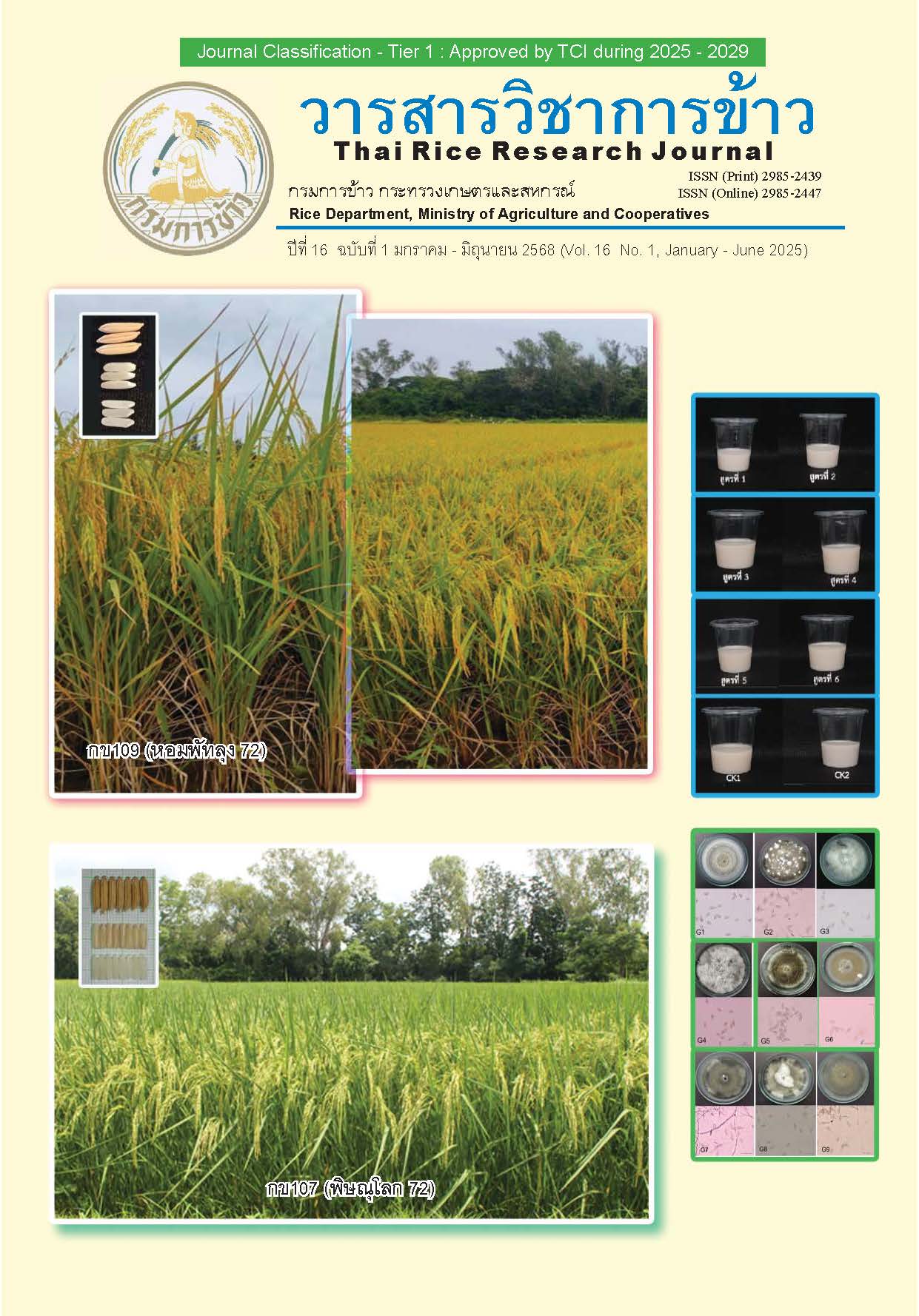คุณค่าทางโภชนาการและสารออกฤทธิ์ทางชีวภาพที่สำคัญในข้าวกล้องจากเชื้อพันธุกรรมข้าวไทย
Main Article Content
บทคัดย่อ
เชื้อพันธุ์ข้าวหลากหลายสายเชื้อพันธุ์ได้มีการรวบรวมไว้ที่ศูนย์ปฏิบัติการและเก็บเมล็ดเชื้อพันธุ์ข้าวแห่งชาติ (ศขช.) ณ ศูนย์วิจัยข้าวปทุมธานี ยังขาดข้อมูลคุณค่าทางโภชนาการและโภชนเภสัช ซึ่งเป็นข้อมูลสำคัญสำหรับให้นักวิจัย และผู้สนใจในการเลือกสายเชื้อพันธุ์ที่โดดเด่นมาใช้ประโยชน์ต่อยอดการพัฒนาผลิตภัณฑ์ งานวิจัยนี้มีวัตถุประสงค์เพื่อให้ได้ข้อมูลคุณค่าทางโภชนาการและสารออกฤทธิ์ทางชีวภาพที่สำคัญในเชื้อพันธุกรรมข้าวไทย ที่เก็บรวบรวมไว้ใน ศขช. โดยการศึกษาจากตัวอย่างเชื้อพันธุ์ข้าว 447 เชื้อพันธุ์ ประกอบด้วยข้าวที่มีเยื้อหุ้มเมล็ดสีน้ำตาล สีแดง และสีดำ ในรูปข้าวกล้องนำมาวิเคราะห์หาปริมาณโปรตีนและไขมัน ผลการวิเคราะห์พบปริมาณโปรตีน ตั้งแต่ร้อยละ 6.08-12.87 โดยเชื้อพันธุ์ไก่ฟ้า (G.S. No. 22045) และเม็ดมะเขือ (G.S. No. 22087) มีปริมาณโปรตีนมากกว่าร้อยละ 12.8 ปริมาณไขมันพบตั้งแต่ร้อยละ 1.84-3.26 โดยเชื้อพันธุ์เหนียวปียา (G.S. No. 9993) และอีมอม (G.S. No.19334) มีปริมาณไขมันมาก ปริมาณสารออกฤทธิ์ทางชีวภาพ ได้แก่ สารฟีนอลิก พบปริมาณตั้งแต่ 98.53-999.25 มิลลิกรัมต่อกิโลกรัม ยกเว้นเชื้อพันธุ์เหลืองไว (G.S. No. 22142) เหนียวดำ (G.S. No. 3359) เหลืองตาแสง 107-17-96 (G.S. No. 951) เหลืองเมืองกาญจน์ (G.S. No. 11057) เหนียวลอย (G.S. No. 4496) หมาแหย่ง (G.S. No. 22763) ข้าวแดงหนัก (G.S. No. 22140) และกลาแต (G.S. No. 22026) ซึ่งเป็นข้าวที่มีเยื้อหุ้มเมล็ดสีแดงและสีดำ พบปริมาณสารฟีนอลิกมากกว่า 1,000 มิลลิกรัมต่อกิโลกรัม สอดคล้องกับปริมาณสารต้านอนุมูลอิสระเมื่อทดสอบด้วยวิธี DPPH มีค่ามากกว่า 1,000 มิลลิกรัมต่อกิโลกรัม ส่วนปริมาณวิตามินอีพบตั้งแต่ 10.71-56.32 มิลลิกรัมต่อกิโลกรัม โดยเชื้อพันธุ์ขาวนางหลวง (G.S. No. 9415) สร้อยขาวสร้อยแดง (G.S. No. 5330) และอีมอม (G.S. No. 19334) พบปริมาณมาก สารแกมมาออไรซานอล พบปริมาณตั้งแต่ 101.46-497.5 มิลลิกรัมต่อกิโลกรัม โดยพบปริมาณมาก ในเชื้อพันธุ์แหลมทอง (G.S. No. 6672) และดอกติ้ว (G.S. No.21597) ข้อมูลที่ได้ครั้งนี้ เช่น เชื้อพันธุ์ไก่ฟ้า และเม็ดมะเขือ ที่พบปริมาณโปรตีนมาก เป็นแหล่งของกรดอะมิโนจำเป็น ย่อยได้ง่าย และไม่ก่อเกิดภูมิแพ้ หรือเชื้อพันธุ์เหนียวลอย หมาแหย่ง และข้าวแดงหนัก ที่มีฤทธิ์ต้านอนุมูลอิสระสูง สำหรับเป็นแนวทางในการใช้ประโยชน์และเพิ่มมูลค่าข้าวหรือนำไปพัฒนาผลิตภัณฑ์
Article Details
เอกสารอ้างอิง
นภัสสร วงเปรียว. 2561. การวิเคราะห์หาปริมาณโปรตีนแร่ธาตุและวิตามินในข้าวพันธุ์พื้นเมืองของจังหวัดเลย. วารสารวิชาการและวิจัย มทร.พระนคร 12(2): 158-171.
นันทยา ชนะรัตน์. 2545. Supervitamin E. วารสารเทคนิคการแพทย์เชียงใหม่ 35(3): 179-183.
ปภาวดี คล่องพิทยาพงษ์ และจันทรรัตน์ จาริกสกุลชัย. 2562. การพัฒนาเภสัชภัณฑ์จากน้ำมันรำข้าวเพื่อสุขภาพ. วารสารวิชาการมหาวิทยาลัยอีสเทิร์นเอเชีย 13(2): 1-16.
ผกามาศ วงค์เตย์, ดารารัตน์ มณีจันทร์, รัตนวรรณ จันทร์ศศิธร, อสมาภรณ์ จัตตุพรพงษ์, นฤมล เสือแดง, ภัทรศยา สายยืด, ศตวรรณ คงสมจิตต์, วัชรี สุขวิวัฒน์, ปราณี มณีนิล และเกศสุดา ปางรัสมี. 2563. ปริมาณสารฟีนอลิกในพันธุ์ข้าวไทย และผลของอุณหภูมิในการเก็บรักษาต่อคุณภาพข้าว. วารสารวิชาการข้าว 11(2): 103-113.
พันทิพา พงษ์เพียจันทร์, ธวัธชัย แถวถาทำ และดำเนิน กาละดี. 2547. ปริมาณแกมมา-โอไรซานอลในผลิตภัณฑ์จากพืชชนิดต่างๆ. วารสารเกษตร 20(2): 111-119
มัชฌิมา นามมูลน้อย, บังอร ศรีพานิชกุลชัย, จิรวัฒน์ สนิทชน และศรัญญา ตันติยาสวัสดิกุล. 2566. การศึกษาคุณค่าทางโภชนาการและฤทธิทางชีวภาพของข้าวพื้นเมืองไทย. วารสารเภสัชศาสตร์อีสาน 19(2): 75-89.
ลัดดา แสงเดือน วัฒนศิริธรรม. 2561. น้ำมันรำข้าวเพื่อสุขภาพ. อาหาร 48(1): 50-55.
สุภาษิต ชูกลิ่น , ธีระพงค์ หมวดศรี และผกามาส ปุรินทราภิบาล. 2563. คุณค่าทางโภชนาการของข้าวกล้องพื้นเมืองตรัง. วารสารวิจัย มหาวิทยาลัยเทคโนโลยีราชมงคลศรีวิชัย 12(2): 285-296.
AOAC. 2000. Official methods of analysis. Association of official analytical chemist. 17th ed., Gaitherburg, Maryland, USA.
Brand-Williams, W., M.E. Cuvelier and C. Berset. 1995. Use of a free radical method to evaluate antioxidant activity. LWT-Food science and Technology 28(1): 25-30.
Chen, M.H. and C.J. Bergman. 2005. A rapid procedure for analysing rice bran tocopherol, tocotrienol and gamma oryzanol contents. Journal of Food Composition and Analysis 18: 319-331.
Dewi, A.M.P., W. Setyaningsih and M. Palma. 2024. Rapid method for simultaneous determination of gamma-oryzanol compounds in rice (Oryza sativa) grains using UV-Vis spectroscopy and chemometrics. Trends in Sciences 21(12): 8550.
Dias, L.G., A. Hacke, E.D.S. Souza, S. Nath, M.R. Canesin, O.V. Vilella, B. Geloneze, J.A.L. Pallone, C.B.B. Cazarin, J.J. Blakeslee, L.R.B. Mariutti and N. Bragagnolo. 2022. Comparison of chemical and nutritional compositions between aromatic and non-aromatic rice from Brazil and effect of planting time on bioactive compounds. Journal of Food Composition and Analysis 111: 104608.
Goffman, F.D. and C.J. Bergman. 2004. Rice kernel phenolic content and its relationship with antiradical efficiency. Journal of the Science of Food and Agriculture 84: 1235-1240.
Heinonen, M. and V. Piironen. 1991. The tocotrienol, and vitamin E content of the average Finnish diet. International Journal for Vitamin and Nutrition Research 61: 27-32
Hoogenkamp, H., H. Kumagai and J.P.D. Wanasundara. 2017. Rice protein and rice protein products. pp.47-65. In: S.R. Nadathur, J.P.D. Wanasundara, L. Scanlin (eds.), Sustainable Protein Sources. Academic Press.
Ishihara, M. 1984. Effect of gamma-oryzanol on serum lipid peroxide level and clinical symptoms of patients with climacteric disturbances. Asia-Oceania Journal of Obstetrics and Gynaecology 10(3): 317-323.
Juliano, B.O., A.A. Antonio and B.V. Esmama. 1973. Effects of protein content on the distribution and properties of rice protein. Journal of the Science of Food and Agriculture 24(3): 295-306.
Kamara, J.S., S. Konishi, T. Sasanuma and T. Abe. 2010. Variation in free amino acid profile among some rice (Oryza sativa L.) cultivars. Breeding Science 60(1): 46-54.
Kato, T. and H. Akira. 2021. Distribution of gamma-oryzanol in the outer layers of brown rice and its variation among cultivars. Plant Production Science 24(2): 256-265.
Kunnam, J., P. Wanwipa, R. Ruttanachira, B. Darika, T. Thanasin and A. Chorkaew. 2023. Stability of phenols, antioxidant capacity and grain yield of six rice genotypes. Plants 12(15). 2787.
Miller, E.L., B.P. Anthony, B.M. Stuart and S. Berni. 2007. Repeatability and reproducibility of determination of the nitrogen content of fishmeal by the combustion (Dumas) method and comparison with the Kjeldahl method: interlaboratory study. Journal of AOAC International 90(1): 6-20.
Oki, T., M. Mami, K. Mio, N. Yoichi, F. Shu, S. Ikua and S. Tetsuo. 2002. Polymeric procyanidins as radical-scavenging components in red-hulled rice. Journal of Agricultural and Food Chemistry 50: 7524-7529.
Qiu, Y., L. Qin and B. Trust. 2010. Antioxidant properties of commercial wild rice and analysis of soluble and insoluble phenolic acids. Food Chemistry 121: 140-147.
Sahu, R., M. Subhajit, D. Priya, A.J. Gouhar, D.K. Tarun, P. Paramita, N. Gouranga and K. Ritu. 2023. The bioavailability, health advantages, extraction method, and distribution of free and bound phenolics of rice, wheat, and maize: A review. Food Chemistry Advances 3: 100484.
Thapa, M., L. Lei, B.J. Bronwyn, K. Tobias, R.Y. Suzy and R.J. Terry. 2024. Accumulation patterns of anthocyanin and gamma-oryzanol during black rice grain development. PLOS One 19(5): 0302745.
Tian, S., K. Nakamura and H. Kayahara. 2004. Analysis of phenolic compounds in white rice, brown rice and germinated brown rice. Journal of Agricultural and Food Chemistry 52(15): 4808-4813.
Ukpong, E.S., E.U. Onyeka and B.S. Oladeji. 2023. Bioactive compounds, nutrients and pasting properties of parboiled milled rice, brown rice and germinated brown rice of selected cultivars and the effects of germination durations. Food Chemistry Advances 2: 100234.
Yu, L., G. Li, M. Li, F. Xu, T. Beta and J. Bao. 2016. Genotypic variation in phenolic acid, vitamin E and fatty acids in whole grain rice. Food Chemistry 197: 776-782.
Zhang, M.W., B.J. Guo, R.F. Zhang, J.W. Chi, Z.C. Wei, Z.H. Xu, Y. Zhang and X.J. Tang. 2006. Separation, purification and identification of antioxidant compositions in black rice. Agricultural Science in China 5: 431-440.
Zhou, Z., R. Kevin, H. Stuart and B. Chris. 2004. The distribution of phenolic acids in rice. Food Chemistry 87(3): 401-406.
Zhu, J., W. Xiaoyu, L. Ao, W. Rannan, N. Xinhua, H. Jinlong, W. Haiyan, Z. Hongcheng and X. Qiangqiang. 2024. The main nutritional components in colored rice grains. LWT-Food Science and Technology 191: 115663.

